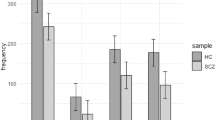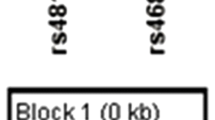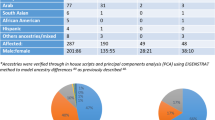Abstract
The enzyme catechol-o-methyltransferase (COMT) transfers a methyl group from adenosylmethionine to catecholamines including the neurotransmitters dopamine, epinephrine and norepinephrine. This methylation results in the degradation of catecholamines. The involvement of the COMT gene in the metabolic pathway of these neurotransmitters has made it an attractive candidate gene for many psychiatric disorders. In this article, we reported our study of association of COMT with schizophrenia in Irish families with a high density of schizophrenia. Three single nucleotide polymorphisms (SNPs) were genotyped for the 274 such families and within-family transmission disequilibrium tests were performed. SNP rs4680, which is the functional Val/Met polymorphism, showed modest association with the disease by the TRANSMIT, FBAT and PDT programs, while the other two SNPs were negative. These SNPs showed lower level of LDs with each other in the Irish subjects than in Ashkenazi Jews. Haplotype analysis indicated that a haplotype, haplotype A-G-A for SNPs rs737865-rs4680-rs165599, was preferentially transmitted to the affected subjects. This was different from the reported G-G-G haplotype found in Ashkenazi Jews, but both haplotypes shared the Val allele. We concluded that COMT gene is associated with schizophrenia and carries a small but significant risk to the susceptibility in the Irish subjects.
This is a preview of subscription content, access via your institution
Access options
Subscribe to this journal
Receive 12 print issues and online access
$259.00 per year
only $21.58 per issue
Buy this article
- Purchase on Springer Link
- Instant access to full article PDF
Prices may be subject to local taxes which are calculated during checkout
Similar content being viewed by others
References
Matsumoto M, Weickert CS, Akil M, Lipska BK, Hyde TM, Hermann MM et al. Catechol O-methyltransferase mRNA expression in human and rat brain: evidence for a role in cortical neuronal function. Neuroscience 2003; 116: 127–137.
Gill M, Vallada H, Collier D, Sham P, Holmans P, Murray R et al. A combined analysis of D22S278 marker alleles in affected sib-pairs: support for a susceptibility locus for schizophrenia at chromosome 22q12. Schizophrenia Collaborative Linkage Group (Chromosome 22). Am J Med Genet 1996; 67: 40–45.
Hovatta I, Lichtermann D, Juvonen H, Suvisaari J, Terwilliger JD, Arajarvi R et al. Linkage analysis of putative schizophrenia gene candidate regions on chromosomes 3p, 5q, 6p, 8p, 20p and 22q in a population-based sampled Finnish family set. Mol Psychiatry 1998; 3: 452–457.
Liu H, Abecasis GR, Heath SC, Knowles A, Demars S, Chen YJ et al. Genetic variation in the 22q11 locus and susceptibility to schizophrenia. Proc Natl Acad Sci USA 2002; 99: 16859–16864.
Gurling HM, Kalsi G, Brynjolfson J, Sigmundsson T, Sherrington R, Mankoo BS et al. Genomewide genetic linkage analysis confirms the presence of susceptibility loci for schizophrenia, on chromosomes 1q32.2, 5q33.2, and 8p21–22 and provides support for linkage to schizophrenia, on chromosomes 11q23.3–24 and 20q12.1–11.23. Am J Hum Genet 2001; 68: 661–673.
Riley B, Mogudi-Carter M, Jenkins T, Williamson R . No evidence for linkage of chromosome 22 markers to schizophrenia in southern African Bantu-speaking families. Am J Med Genet 1996; 67: 515–522.
Straub RE, MacLean CJ, Ma Y, Webb BT, Myakishev MV, Harris-Kerr C et al. Genome-wide scans of three independent sets of 90 Irish multiplex schizophrenia families and follow-up of selected regions in all families provides evidence for multiple susceptibility genes. Mol Psychiatry 2002; 7: 542–559.
Williams NM, Rees MI, Holmans P, Norton N, Cardno AG, Jones LA et al. A two-stage genome scan for schizophrenia susceptibility genes in 196 affected sibling pairs. Hum Mol Genet 1999; 8: 1729–1739.
Vogels A, Verhoeven WM, Tuinier S, DeVriendt K, Swillen A, Curfs LM et al. The psychopathological phenotype of velo-cardio-facial syndrome. Ann Genet 2002; 45: 89–95.
Karayiorgou M, Morris MA, Morrow B, Shprintzen RJ, Goldberg R, Borrow J et al. Schizophrenia susceptibility associated with interstitial deletions of chromosome 22q11. Proc Natl Acad Sci USA 1995; 92: 7612–7616.
Egan MF, Goldberg TE, Kolachana BS, Callicott JH, Mazzanti CM, Straub RE et al. Effect of COMT Val108/158 Met genotype on frontal lobe function and risk for schizophrenia. Proc Natl Acad Sci USA 2001; 98: 6917–6922.
Glatt SJ, Faraone SV, Tsuang MT . Association between a functional catechol O-methyltransferase gene polymorphism and schizophrenia: meta-analysis of case–control and family-based studies. Am J Psychiatry 2003; 160: 469–476.
Li T, Ball D, Zhao J, Murray RM, Liu X, Sham PC et al. Family-based linkage disequilibrium mapping using SNP marker haplotypes: application to a potential locus for schizophrenia at chromosome 22q11. Mol Psychiatry 2000; 5: 77–84.
Ohmori O, Shinkai T, Kojima H, Terao T, Suzuki T, Mita T et al. Association study of a functional catechol-O-methyltransferase gene polymorphism in Japanese schizophrenics. Neurosci Lett 1998; 243: 109–112.
Rybakowski JK, Borkowska A, Czerski PM, Hauser J . Eye movement disturbances in schizophrenia and a polymorphism of catechol-O-methyltransferase gene. Psychiatry Res 2002; 113: 49–57.
Shifman S, Bronstein M, Sternfeld M, Pisante-Shalom A, Lev-Lehman E, Weizman A et al. A highly significant association between a COMT haplotype and schizophrenia. Am J Hum Genet 2002; 71: 1296–1302.
Strous RD, Bark N, Parsia SS, Volavka J, Lachman HM . Analysis of a functional catechol-O-methyltransferase gene polymorphism in schizophrenia: evidence for association with aggressive and antisocial behavior. Psychiatry Res 1997; 69: 71–77.
Geller B, Cook Jr EH . Ultradian rapid cycling in prepubertal and early adolescent bipolarity is not in transmission disequilibrium with val/met COMT alleles. Biol Psychiatry 2000; 47: 605–609.
Lachman HM, Morrow B, Shprintzen R, Veit S, Parsia SS, Faedda G et al. Association of codon 108/158 catechol-O-methyltransferase gene polymorphism with the psychiatric manifestations of velo-cardio-facial syndrome. Am J Med Genet 1996; 67: 468–472.
Mattay VS, Goldberg TE, Fera F, Hariri AR, Tessitore A, Egan MF et al. Catechol O-methyltransferase val158-met genotype and individual variation in the brain response to amphetamine. Proc Natl Acad Sci USA 2003; 100: 6186–6191.
Rujescu D, Giegling I, Gietl A, Hartmann AM, Moller HJ . A functional single nucleotide polymorphism (V158 M) in the COMT gene is associated with aggressive personality traits. Biol Psychiatry 2003; 54: 34–39.
Tsai SJ, Yu YW, Chen TJ, Chen JY, Liou YJ, Chen MC et al. Association study of a functional catechol-O-methyltransferase-gene polymorphism and cognitive function in healthy females. Neurosci.Lett 2003; 338: 123–126.
Kotler M, Barak P, Cohen H, Averbuch IE, Grinshpoon A, Gritsenko I et al. Homicidal behavior in schizophrenia associated with a genetic polymorphism determining low catechol O-methyltransferase (COMT) activity. Am J Med Genet 1999; 88: 628–633.
Wonodi I, Stine OC, Mitchell BD, Buchanan RW, Thaker GK . Association between Val108/158 Met polymorphism of the COMT gene and schizophrenia. Am J Med Genet 2003; 120B: 47–50.
Fan JB, Chen WY, Tang JX, Li S, Gu NF, Feng GY et al. Family-based association studies of COMT gene polymorphisms and schizophrenia in the Chinese population. Mol Psychiatry 2002; 7: 446–447.
Kremer I, Pinto M, Murad I, Muhaheed M, Bannoura I, Muller DJ et al. Family-based and case–control study of catechol-O-methyltransferase in schizophrenia among Palestinian Arabs. Am J Med Genet 2003; 119B: 35–39.
Kunugi H, Vallada HP, Sham PC, Hoda F, Arranz MJ, Li T et al. Catechol-O-methyltransferase polymorphisms and schizophrenia: a transmission disequilibrium study in multiply affected families. Psychiatr Genet 1997; 7: 97–101.
Semwal P, Prasad S, Bhatia T, Deshpande SN, Wood J, Nimgaonkar VL et al. Family-based association studies of monoaminergic gene polymorphisms among North Indians with schizophrenia. Mol Psychiatry 2001; 6: 220–224.
Lotta T, Vidgren J, Tilgmann C, Ulmanen I, Melen K, Julkunen I et al. Kinetics of human soluble and membrane-bound catechol O-methyltransferase: a revised mechanism and description of the thermolabile variant of the enzyme. Biochemistry 1995; 34: 4202–4210.
Bray NJ, Buckland PR, Williams NM, Williams HJ, Norton N, Owen MJ et al. A haplotype implicated in schizophrenia susceptibility is associated with reduced COMT expression in human brain. Am J Hum Genet 2003; 73: 152–161.
Kendler KS, MacLean CJ, O'Neill FA, Burke J, Murphy B, Duke F et al. Evidence for a schizophrenia vulnerability locus on chromosome 8p in the Irish Study of High-Density Schizophrenia Families. Am J Psychiatry 1996; 153: 1534–1540.
Kendler KS, Myers JM, O'Neill FA, Martin R, Murphy B, MacLean CJ et al. Clinical features of schizophrenia and linkage to chromosomes 5q, 6p, 8p, and 10p in the Irish Study of High-Density Schizophrenia Families. Am J Psychiatry 2000; 157: 402–408.
Straub RE, Jiang Y, MacLean CJ, Ma Y, Webb BT, Myakishev MV et al. Genetic variation in the 6p22.3 gene DTNBP1 . the human ortholog of the mouse dysbindin gene, is associated with schizophrenia. Am J Hum Genet 2002; 71: 337–348.
American Psychiatric Association. Diagnostic and statistical manual of mental disorders Edition III-R. 3rd edn 1987.
Kendler KS, McGuire M, Gruenberg AM, Spellman M, O′Hare A, Walsh D . The Roscommon Family Study. II. The risk of nonschizophrenic nonaffective psychoses in relatives. Arch Gen Psychiatry 1993; 50: 645–652.
Chen X, Levine L, Kwok PY . Fluorescence polarization in homogeneous nucleic acid analysis. Genome Res 1999; 9: 492–498.
van den Oord EJ, Jiang Y, Riley BP, Kendler KS, Chen X . FP-TDI SNP scoring by manual and statistical procedures: a study of error rates and types. Biotechniques 2003; 34: 610–620, 622.
Clayton D . A generalization of the transmission/disequilibrium test for uncertain-haplotype transmission. Am J Hum Genet 1999; 65: 1170–1177.
Clayton D, Jones H . Transmission/disequilibrium tests for extended marker haplotypes. Am J Hum Genet 1999; 65: 1161–1169.
Horvath S, Xu X, Laird NM . The family based association test method: strategies for studying general genotype–phenotype associations. Eur J Hum Genet 2001; 9: 301–306.
Laird NM, Horvath S, Xu X . Implementing a unified approach to family-based tests of association. Genet Epidemiol 2000; 19(Suppl 1): S36–S42.
Martin ER, Monks SA, Warren LL, Kaplan NL . A test for linkage and association in general pedigrees: the pedigree disequilibrium test. Am J Hum Genet 2000; 67: 146–154.
Sobel E, Lange K . Descent graphs in pedigree analysis: applications to haplotyping, location scores, and marker-sharing statistics. Am J Hum Genet 1996; 58: 1323–1337.
Liou YJ, Tsai SJ, Hong CJ, Wang YC, Lai IC . Association analysis of a functional catechol-o-methyltransferase gene polymorphism in schizophrenic patients in Taiwan. Neuropsychobiology 2001; 43: 11–14.
Wei J, Hemmings GP . Lack of evidence for association between the COMT locus and schizophrenia. Psychiatr Genet 1999; 9: 183–186.
Risch N, de Leon D, Ozelius L, Kramer P, Almasy L, Singer B et al. Genetic analysis of idiopathic torsion dystonia in Ashkenazi Jews and their recent descent from a small founder population. Nat Genet 1995; 9: 152–159.
Acknowledgements
We thank Dr Yihua Che and Ms Shoan Hossain for their technical assistance for PCR primer design and optimization. This study is supported by research grant (RO1MH41953) to KSK from the National Institute of Mental Health.
Author information
Authors and Affiliations
Corresponding author
Rights and permissions
About this article
Cite this article
Chen, X., Wang, X., O'Neill, A. et al. Variants in the catechol-o-methyltransferase (COMT) gene are associated with schizophrenia in Irish high-density families. Mol Psychiatry 9, 962–967 (2004). https://doi.org/10.1038/sj.mp.4001519
Received:
Revised:
Accepted:
Published:
Issue Date:
DOI: https://doi.org/10.1038/sj.mp.4001519
Keywords
This article is cited by
-
Prediction of functional outcomes of schizophrenia with genetic biomarkers using a bagging ensemble machine learning method with feature selection
Scientific Reports (2021)
-
ZNF804A rs1344706 interacts with COMT rs4680 to affect prefrontal volume in healthy adults
Brain Imaging and Behavior (2018)
-
Association studies of genomic variants with treatment response to risperidone, clozapine, quetiapine and chlorpromazine in the Chinese Han population
The Pharmacogenomics Journal (2016)
-
Voxelwise eigenvector centrality mapping of the human functional connectome reveals an influence of the catechol-O-methyltransferase val158met polymorphism on the default mode and somatomotor network
Brain Structure and Function (2016)
-
COMT-Polymorphismus und GST-Mangel
NeuroTransmitter (2013)



